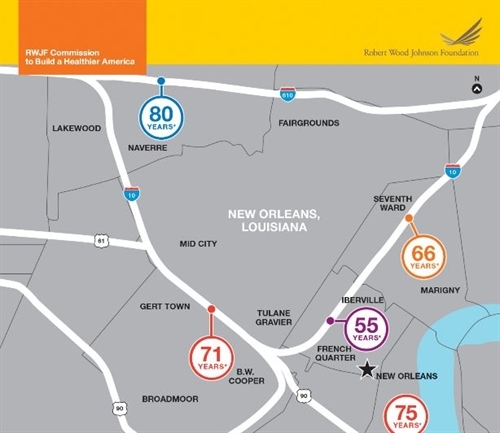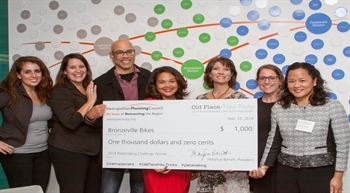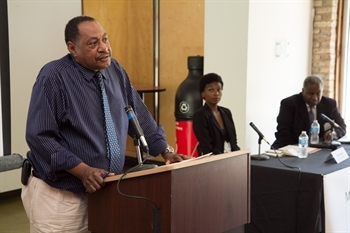
Ryan Griffin-Stegink
Panelists Eboni Hawkins and Cortez Trotter
When you hear the term “health disparities,” what comes to mind? We often think of them on a massive scale, such as rates of disease and life expectancy between the U.S. and Haiti. A recent series of maps from the Robert Wood Johnson Foundation indicates that, in fact, we need not look that far afield to face profound divergences in overall wellness. Many U.S. cities, it turns out, house the whole spectrum of healthy living within their own borders. Consider this map of New Orleans, where single-digit miles separate a life expectancy of 80 years from 55:

Life expectancy, New Orleans
Robert Wood Johnson Foundation
So how about here in Chicago? If a map were made of our city, what differences would we see between the Gold Coast and Englewood? Or between Hyde Park and Little Village? And what are Chicagoans doing about it?
On July 25, 2013, at a BlueCross BlueShield of Illinois-sponsored event, "Planning Active, Healthy Communities" held at the Little Black Pearl in Bronzeville, we heard from three people employing distinct approaches to address inequalities in health, in a room packed with people working on similar issues from Blue Island to Humboldt Park to Evanston.
As director of community building at Centers for New Horizons in Bronzeville, Johnnie Owens detailed his organization’s three-pronged approach, which introduces urban agriculture, encourages healthier corner stores and establishes Health & Wellness counselors at local schools.

Bronzeville Bikes' architecture tour, 7/28/13
Bernard Loyd
Meanwhile, Eboni Hawkins, Programs Manager for Bronzeville Bikes and Co-founder of Red Bike & Green, is working with resident biking enthusiasts to build a biking culture in Bronzeville. One strategy combines bike rides and community exploration through themed bike tours of Bronzeville. I attended this past Sunday’s tour of architecturally significant buildings, and it struck me that the tour delivers a powerful one-two punch: Not only do Bronzeville residents learn about their own community’s history and have increased pride of place, the tour also attracts participants from other areas of the city, who will be much more likely to return and dine in a local restaurant or check out the neighborhood comedy club.
Finally, Cortez Trotter, Executive Director of Woodlawn Public Safety Alliance, talked about working to reduce violence in the South Side neighborhood of Woodlawn using the Blue Cross Blue Shield-funded Play Streets as a vehicle to build relationships with young people while engaging them in healthy activities.
Trotter rightly pointed out that many disparities in rates of violence and life expectancy are rooted in complicated history and policies. As I’ve blogged before, national data show that African-American and Latino adolescents are more likely to live in high-crime areas than are White teens, and that neighborhoods with more serious crime generally have residents who are less active overall. [1] In another Active Living Research study, “Do All Children Have Places to Be Active?,” researchers found that lower-income groups and minorities have more limited access to well-maintained or safe parks and recreational facilities, which can partially explain the low leisure-time physical activity levels and high rate of obesity among racial or ethnic minority and lower-income children.
So what do the projects we heard about at the “Planning Active, Healthy Communities” event demonstrate to us? Hawkins noted that creating a healthier culture can be as simple as getting a bike and having people see you riding it. Owens’ work on expanding corner stores’ healthy selections shows that sometimes all it takes is actually getting to know store owners and educating them on healthier options that the community would like to see.

Moderator Johnnie Owens
Ryan Griffin-Stegink
Addressing health disparities can be that simple, but it may also need to be more than that: We heard from community leaders in Bronzeville and Woodlawn who are pushing to change residents' access to and comfort level with being physically active, but policy makers, planners and city leaders also have a responsibility to prioritize the creation and maintenance of the infrastructure for healthy communities. We can't have strong, healthy neighborhoods without it.
[1] Gordon-Larsen P, McMurray RG , Popkin BM. “Determinants of Adolescent Physical Activity and Inactivity Patterns.” Pediatrics, 105:e83, 2000.